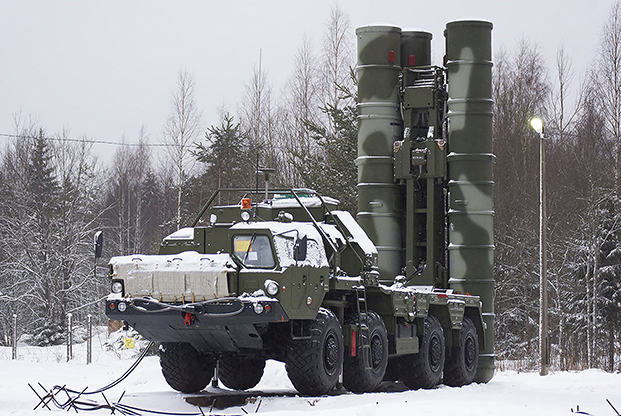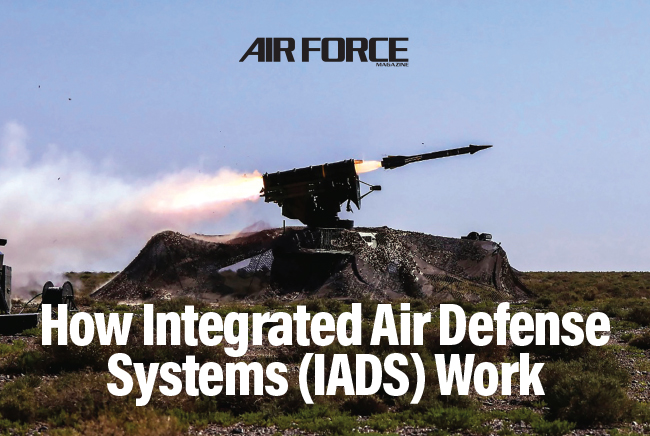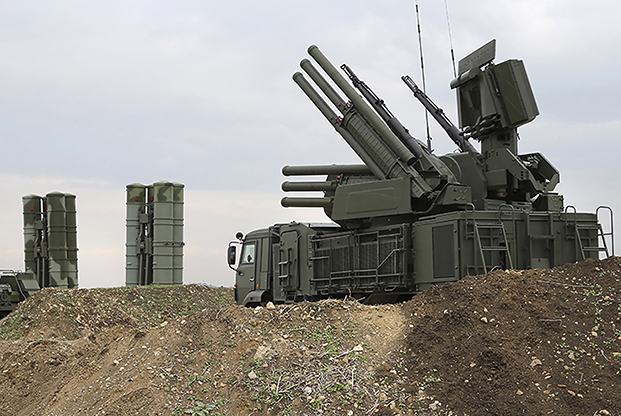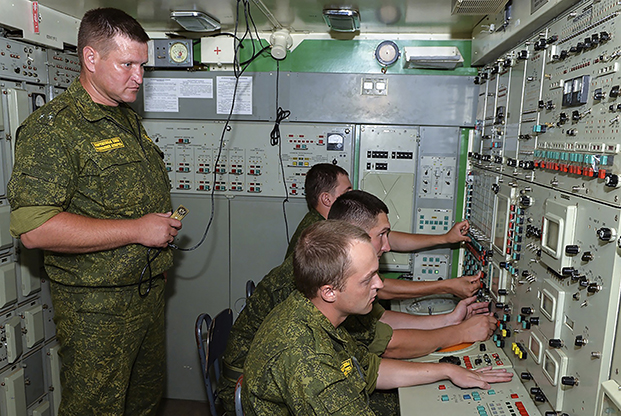
A Russian S-400 SAM system on alert during an exercise near Leningrad in 2017. An IADS allows SAMs to engage multiple threats seamlessly. Photo: Russian Ministry of Defense
Air defense, long neglected in the low-threat air campaigns that dominated the past 18 years of combat operations, is again at the fore of defense planning. The June 2019 shootdown of a US Navy RQ-4A high-altitude remotely piloted aircraft (RPA) variant flying over the Persian Gulf by Iran’s Revolutionary Guard forces raised tensions significantly between the United States and Iran, nearly leading to a retaliatory military strike. The high-altitude intelligence, surveillance, and reconnaissance (ISR) aircraft, used extensively for operations in the Middle East, was brought down by an Iranian derivative of the Russian Buk M3 (SA-17), a medium-range surface-to-air missile (SAM) system.
The relative ease with which Iran shot down the US ISR asset raised concerns among many defense analysts and observers. Mitchell Institute Dean and retired Air Force Lt. Gen. David A. Deptula said subsonic, nonstealth aircraft such as the RQ-4 “were not designed to operate in areas covered by advanced SAM or air-to-air threats.” Advanced SAM threats have proliferated around the world, he said, even to second-rate military powers like Iran.
Senior Air Force and Department of Defense officials have been warning about this threat for some time. In late 2015, then-Maj. Gen. VeraLinn Jamieson—retiring soon after being the Air Force’s three-star deputy chief of staff for ISR and cyber effects operations—co-authored a Mitchell Institute Forum paper, “An ISR Perspective on Fusion Warfare,” that forecast an array of anti-access and area-denial (A2/AD) threats proliferating around the world by 2030 that threaten American airpower’s historic reach and dominance. These threats include hypersonic weapons, air-to-air missiles with ranges exceeding 150 nautical miles, and long-range surface-to-air missiles with reaches of up to 500 nm. In another decade or so, the paper warned, potential adversaries could enhance traditional ground-based radar detection with advanced passive detection systems and tools such as cyber capabilities, advancing their primary goal of “attacking and disabling our capabilities before we employ them.”
America’s technological edge, as the 2018 National Defense Strategy pointed out, is under pressure from would-be adversaries looking to dull the competitive edge the US Air Force could once virtually guarantee in any conflict. As famed airpower theorist and retired USAF Col. John A. Warden III once observed, since 1939, “no country has won a war in the face of enemy air superiority, no major offensive has succeeded against an opponent who controlled the air, and no defense has sustained itself against an enemy who had air superiority.” Attaining air superiority, he added, has “consistently been a prelude to military victory.” America’s adversaries and rivals, especially since observing the success of Operation Desert Storm, know this acutely, and are not simply focused on increasing the accessibility and range of their weapons. They are instead developing holistic capabilities that operate in every domain—land, sea, air, space, cyberspace, and across the electromagnetic spectrum. These are not just offensive capabilities, but defensive tools to thwart American airpower’s ability to seize the initiative and establish air supremacy in any future conflict. These defensive capabilities, such as radars, communication systems, and SAMs, are purposely organized into what is termed an “integrated air defense system”—or an IADS.
 Click here or on the photo above to view the Mitchell Institute’s full-size infographic as a PDF. Teaser graphic: Dashton Parham; Source photo: Zhou Rui and Hu Yonghui/China Ministry of Defense
Click here or on the photo above to view the Mitchell Institute’s full-size infographic as a PDF. Teaser graphic: Dashton Parham; Source photo: Zhou Rui and Hu Yonghui/China Ministry of Defense
WHAT IS AN IADS
A modern IADS is far more complex than a singular SAM battery or its associated command vehicle and radar. Analysts and operational planners should strive to use a common language when discussing IADS, and incorporate this knowledge in order to plan against these complex systems as missions dictate. This understanding must include recognition that a linear, simplistic approach to defeating modern, complex IADS is insufficient and instead requires integrated multi-domain operations.
An IADS is the “structure, equipment, personnel, procedures, and weapons used to counter the enemy’s airborne penetration of one’s own claimed territory,” according to one Air Force intelligence expert. Rather than a single weapon or person, it is an amalgamation of elements, organized to minimize threats in the air domain. Thus, an effective IADS performs three functions—air surveillance, battle management, and weapons control. Of these, air surveillance alone includes five specific sub-functions: detect, initiate, identify, correlate, and maintain.
Air surveillance is often described as the “eyes” of an air defense system. A radar will “detect” an aircraft entering an IADS’s area of coverage, while the “initiate” function transforms radar returns into “tracks.” The “identify” function examines the track and categorizes it as friend, foe, or unknown.
These three phases occur relatively independently, which necessitates a “correlate” function. For example, if a system sees three tracks in close proximity, a sensor operator has the option to consider the tracks a single entity or three different aircraft. Correlation is important as it can have a significant impact on weapon resourcing. Finally, the “maintain” function allows for specific tracks to be continuously monitored. In modern systems, much of this can be automated, resulting in less “man in the loop” processing and more “man on the loop” paradigms. This reduces the ability to defeat the human factor in a modern IADS, and there is more importance given to the ability to generate multiple effects on air surveillance nodes in order to degrade the awareness of an IADS.
After surveillance, the battle management aspect of an IADS includes four functions: Threat evaluation, engagement decision, weapon selection, and engagement authority. Battle management marks the transition from identifying a threat to acting against it. Battle management makes the determination that a given radar track is in fact a threat and then selects the weapon to counter that threat. The engagement authority is the final step in battle management that confirms the threat, engagement, and weapon selection decisions.
These decisions transition into weapons control, where a particular weapon system performs the weapons pairing, acquiring, tracking, guiding, killing, and assessing functions. Within weapons control, even more refined degrees of air surveillance and battle management tasks are occurring too. The difference is these are strictly related to the specific weapon that is engaging a threat.
The complexity of modern command, control, communications, computers, and intelligence (C4I) systems, and processes used by IADS are often underestimated. For instance, it would be unusual to observe an individual weapon system component of an IADS, such as a fire-control radar, providing air surveillance within an IADS. Because these weapon systems share similarities with air surveillance tools, they appear as though they can do just that, and are often mistakenly thought to perform the same task.
As a result, the control functions and guidance aspects of air defense are often analyzed more than other elements of an IADS’ kill chain. This is because capabilities such as fire-control radars and missile batteries that make decisions and have their own radars are perceived as performing these functions across the entire system, irrespective of a weapon’s role or responsibility in a larger IADS.
Modern IADS leverage multiple communications channels, including traditional landlines, fiber-optic networks, and radio frequency and electromagnetic spectrum links. No longer can an operation against a modern IADS plan to achieve a singular effect against a singular node or IADS means of communication.
 A Russian self-propelled medium-range surface-to-air missile and gun system (right), the Pantsir S1, guards an air base in Syria in 2015. Two S-400 SAM launchers are on the left. The systems are used together in Russian IADS. Photo: Russian Federation Ministry of Defense
A Russian self-propelled medium-range surface-to-air missile and gun system (right), the Pantsir S1, guards an air base in Syria in 2015. Two S-400 SAM launchers are on the left. The systems are used together in Russian IADS. Photo: Russian Federation Ministry of Defense
AIR DEFENSE AND THE IADS
Air defense, as its name implies, is the act of safeguarding some protected asset or assets—specifically against threats from the air domain. But not all militaries approach air defense with a similar mindset.
Russia, for example, stipulates that air defense units are to “protect troops and facilities from a different means of air attack (strike aviation, cruise missiles, UAVs) in a combined-arms combat environment and on the march,” according to Russian ground force doctrine. In support of this responsibility, Russian air defense units carry out: air defense combat, detection of enemy aircraft and providing warning for ground units, destruction of the means of an enemy air attack, and theater missile defense support. By contrast, the US Air Force has historically mischaracterized air defense weapons systems based on their range and altitude. A tactical SAM, for example, is considered a short-range system, while a strategic SAM is viewed as a longer-range system. The assigned mission and defended asset, though, should be the key consideration when trying to understand weapon roles in IADS. As such, the tactical or strategic nomenclature of a specific air defense system should not be tied to its range. Although a positive correlation does often exist, this view of air defense could result in misunderstanding the impact an air defense weapon could have in a defended region and in misprioritizing effects against a particular system. This could result in the destruction of a component that matters little to the operation at hand where disruption or denial effects could suffice.
Russian SAMs are fielded across all of the country’s military services, and what makes a given system tactical or strategic is the nature of the target or area the SAM is defending—what Warden called the “center of gravity.” The determinant could include leadership, facilities, forward echelons of fielded forces, or other concerns. These centers are defined by their apportionment to a specific command and control (C2) structure and assigned mission. This is an important distinction as the S-300, -400, and -500 SAM systems have tremendous advertised ranges—some reaching out to 500 miles—while most Russian air defense assets are of the short- and medium-range variety, according to recent analysis. A range, in distance, is thus more closely aligned to the primacy a given system has within an IADS. An S-500, with a reported 500-mile reach, would likely be the first line of defense for an IADS over the expected combat radius of a Su-35 Flanker or a Pantsir-S1 missile system.
The term “air defense” provides the functional characteristic of an IADS from a target development perspective, and aids in understanding what a specific system does, how it functions within a greater target system, and its significance. It is obvious that systems like the S-400 or the Pantsir are designed for air defense. But other systems, such as the Su-35 or the MiG-35 Fulcrum fighters, may also provide air defense, just as the US Air Force F-15C Eagle performs the defensive counter-air (DCA) mission. The same is true also for electronic warfare systems; other defense capabilities can and do indirectly or directly affect air operations and support air defense.

Russian military personnel monitor data in an S-300 command and control trailer during an exercise at the Ashuluk Firing Range in Astrakhan, Russia, in 2016. Photo: Russian Federation Ministry of Defense
A SYSTEM OF SYSTEMS
Across the US Air Force, SAM systems are often misunderstood as a singular key component, like a missile battery or radar, for targeting purposes. This unintentionally de-emphasizes the other components of both the SAM system and the greater IADS. Thus, the question should be answered—what is a system, in the context of the IADS discussion
A system like an S-400 SAM should not be viewed simply as a transporter-erector-launcher (TEL) or a single radar. The Russians themselves describe the S-400 as consisting of a battle management system, six separate SAM systems, maintenance facilities, and other nodes. At least seven vehicles are required for the S-400 system to carry out its mission, according to Russian defense literature, and that does not include C2 vehicles, generators, fuel and oil, engineering equipment, and support personnel—or the defended asset itself.
An S-400 is therefore just one component in a series of systems that make up the IADS. There could be one S-400 or multiple S-400s in an IADS, depending on the mission or the area to be defended. Different weapons could be tied together with dissimilar capabilities as well, such as pairing an S-400 with a Pantsir-S1—a shorter-range road-mobile SAM capability. A literal analysis would falsely conclude that this is just a two systems working in close proximity. The reality is that the Pantsir and the S-400 are part of an integrated system. The Pantsir-S1 is often used to reinforce air defense groupings when repelling “massive air attacks,” according to literature from the weapon’s manufacturer, Rosoboronexport. This has direct parallels to aircraft and electronic warfare capabilities. Ultimately, all these systems are interconnected in order to provide a seamless integrated defense.
INTEGRATION AND AIR DEFENSE
Integration marries a variety of systems into an efficient defensive enterprise, and allows for the three functions of an IADS to occur simultaneously and repeatedly. In effect, it takes the linear IADS kill chain and allows parallel kill chains to occur concurrently within the broader system. Outdated approaches to defeat IADS are reminiscent of the childhood “telephone game”—where one breaks a link in the chain and the whole system fails. Modern IADS, though, are more resilient and operate much like social media platforms: Removing one user or component does not stop a Facebook post from spreading. The use of multiple attacks to deny, delay, and degrade the “message” must occur in an IADS, since it is improbable that any one attack can permanently break every critical link.
At the component level, some systems have the ability to run a localized version of an IADS. The S-400 has its own organic air surveillance capability, battle management, and engagement functions. But a single S-400 operating independently is not providing air defense alone. In this case, a single S-400 would (at a minimum) work closely with a Pantsir-S1 to provide comprehensive air defenses to maximize the strength of one system, while mitigating weakness and vulnerabilities of the other system. Said another way, an IADS enterprise prevents an Su-35, S-400, or a Pantsir-S1 from engaging a single threat at the same time but allows for each system to engage multiple threats seamlessly. This is done with redundant modern communications tools, including satellite communications, 4G (and now 5G) cellular networks, public switch telephone networks, data links, Wi-Fi networks, cloud computing, and others. Not only does the modern range of communications networks allow for redundancy, it also allows for the seamless passage of data—irrespective of a unit’s echelon or span of control. The hierarchical or linear understanding of an IADS, thus, is not the correct representation of the interoperability of tactical units to higher headquarters units.
Modern integration allows the concept of “skip echelon” to occur with regularity, where communications skip an intermediate step of an organization. If a mid-level battle management node is destroyed or isolated from the rest of an IADS in a combat action, an individual air defense unit can reach out directly to a division or leadership headquarters. This represents a significant change from the Iraqi IADS of Operation Desert Storm, the Serbian IADS of Operation Allied Force, or even the Libyan IADS of Operation Odyssey Dawn. Most of these IADS, built with 1980s—or even 1970s—technology, featured limited communications means and static assignment of air defense roles. Today’s modern IADS can be integrated via the networks and tools listed above, allowing for more seamless data sharing, limited only by commanders’ decisions to delegate roles, responsibilities, and decision-making. The paradigm of “IADS rollback” in modern air operations, as a result, is woefully outdated if not adapted to a multi-domain, multi-effect approach. A modern IADS can now easily mitigate the destruction or isolation of singular nodes potentially faster than the complex problem-solving approach to current rollback strategies.
CONCLUSION AND RECOMMENDATIONS
The 2018 National Defense Strategy identifies Russia and China as “revisionist powers” that aim to challenge US military advantage in every domain. Modern IADS, as described above, enable these nations to challenge the US military and create environments where they can potentially project their own forces to degrade and eliminate American advantage. It is therefore imperative that intelligence analysts and planners understand and adopt a thorough understanding of modern, complex IADS in order to properly communicate about these threats to decision-makers at the tactical, operational, and strategic level, in support of campaign goals. A common understanding must be shared across all levels of leadership to create a shared model and enable a culture of critical thinking that will be crucial to defeating modern IADS.
The reliance on traditional IADS rollback strategies should be phased out of modern joint combat operations. Instead, leaders and planners should encourage true joint campaign interoperability by harnessing both lethal and nonlethal effects across domains to defeat air defenses. Analysts and planners must understand that in future conflicts, total destruction or denial of singular nodes or mediums of communication may never occur. More realistic will be to seek effects that disrupt, degrade, or delay, and to simultaneously apply force to achieve those effects to allow for the destruction of enemy centers of gravity—including IADS.
Ultimately, military analysts and campaign planners should heed the lessons from Operations Desert Storm, Allied Force, and Odyssey Dawn, while striving to adapt their operational approaches for more sophisticated threats in order to ensure the US Air Force’s unique ability to seize the initiative in future conflicts. A full understanding of adversary IADS centers of gravity—which include human dependencies, critical equipment and infrastructure, communications, plans, and deployment and employment tactics, techniques, and procedures—remains crucial to developing and executing an effective multi-domain counter-IADS strategy. These requirements will only rise as system complexity steadily increases, and defense technologies improve through the 2030s and beyond.
_____
Maj. Peter W. Mattes, USAF, is an intelligence officer currently serving as director of operations at the 19th Weapons Squadron, Nellis AFB, Nev.—part of the US Air Force Weapons School. Prior assignments include support for a variety of Air Force platforms and missions, including the F-16CM, the Distributed Common Ground System (DCGS), and Air Operation Centers (AOCs). He has deployed in support of operations Odyssey Dawn, Unified Protector, New Dawn, Freedom’s Sentinel, Resolute Support, Restore Hope, and Inherent Resolve. This article is adapted from the Mitchell Forum paper, “Systems of Systems: What Exactly is an Integrated Air Defense System” which can be downloaded in its entirety at: www.mitchellaerospacepower.org. The views and opinions expressed here are those of the author and do not necessarily reflect the views of the US Air Force or the Department of Defense.